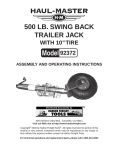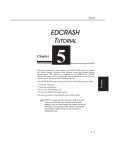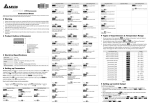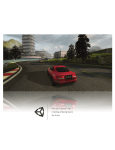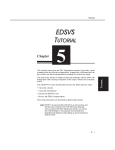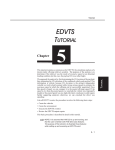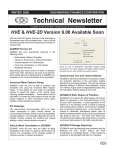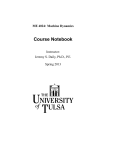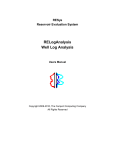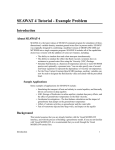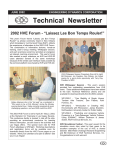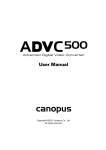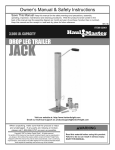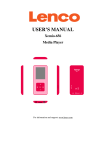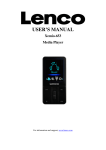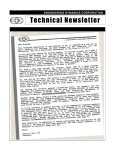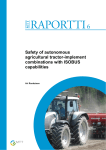Download Tutorial - Engineering Dynamics Corporation
Transcript
Description Tutorial EDSMAC TUTORIAL +D=FJAH 5 This tutorial illustrates a very common use of EDSMAC, that is, to perform a time-distance study to evaluate accident avoidability. We’ll be able to watch as the vehicles approach each other and determine the first point of visibility between vehicles. This tutorial is a continuation of the EDCRASH Tutorial, wherein the initial vehicle velocities were estimated. You may wish to review that tutorial before continuing. Like all EDSMAC events, the procedure involves the following basic steps: Create the vehicle(s) Create the environment Execute the EDSMAC event Review the EDSMAC output reports This basic procedure is described in detail in this tutorial. It is assumed that HVE-2D is up and running, and + NOTE: that the user is familiar with HVE-2Ds basic features, such as using dialogs and viewers, as well as the HVE-2D Editors. The purpose of this tutorial is to illustrate those features while setting up and executing an EDSMAC event. 5-1 TUTORIAL Description EDSMAC Getting Started Getting Started If you just finished the EDCRASH Tutorial, you + NOTE: have already created your vehicles and environment and may proceed directly to page 5-11, Creating the Events. The same suggestion applies if you already did the EDCRASH Tutorial and saved the case; if so, simply open that case and skip to page 5-11. As in other tutorials, before we get started with our current tutorial, let’s set the user options so we’re all starting on the same page. All options simply affect the appearance in a viewer + NOTE: during Event or Playback mode. Some of the following options are Toggles that + NOTE: switch between two different modes. Make sure these options are set correctly. To set the initial user options, choose the following from the Options Menu: â â â â â â â ON: Show Key Results OFF: Show Axes OFF: Show Velocity Vectors ON: Show Skidmarks OFF: Show Targets ON: AutoPosition Units equals S.I. As well see when we create the environment, our + NOTE: EDSMAC Tutorial takes place in Australia; thus, we require metric units. â Render Options: Show Vehicles as Actual Phong Render Method Complexity equals Object Render Quality equals 5 Texture Quality equals 1 Anti-aliasing equals 1 The remaining options will automatically initialize to their default conditions. We’re now ready to proceed with the tutorial. 5-2 Creating the Vehicles Tutorial Creating the Vehicles Let’s add the vehicles to our case. The first vehicle is a white, 1996 Ford Escort 2-Door Hatchback; the second vehicle is a dark red 1995 Nissan Sentra 4-door Sedan. Let’s add the first vehicle: â If the Vehicle Editor is not the current editor, choose Vehicle Mode. The Vehicle Editor is displayed. â Click Add New Object. The Vehicle Information dialog is displayed. The Vehicle Information dialog allows the user to select the basic vehicle attributes according to Type, Make, Model, Year and Body Style. The Vehicle Information dialog also allows you to + NOTE: edit the Driver Location, Engine Location, Number of Axles and Drive Axle(s). These options are assigned default values for each vehicle. For our tutorial, only driver location must be edited. â Using the option buttons, click each button to choose the TUTORIAL following vehicle from the database: Type = Passenger Car Make = Ford Model = Escort Year = 1991-1996 Body Style = 2-Door Hatchback Driver Location = Right â Click OK to add Ford Escort 2-Dr Hatchback to the Active Vehicles list. The Ford Escort is added to the case. Next, let’s add the Nissan Sentra. â Click Add New Object. The Vehicle Information dialog is displayed. â Using the option buttons, click each button to choose the following vehicle from the database: Type = Passenger Car Make = Nissan Model = Sentra Year = 1995-1999 Body Style = 4-Door Driver Location = Right â Click OK to add Nissan Sentra 4-Dr to the Active Vehicles list. We now have the vehicles required for our study, as shown in Figure 5-1. 5-3 EDSMAC Creating the Vehicles Figure 5-1 Ford Escort 2-Dr Hatchback (above) and Nissan Sentra 4-Dr (below). 5-4 Creating the Vehicles Tutorial Editing the Vehicles Next, we’ll edit the vehicles to change their color and weight. In addition, we’ll change the stiffness of the Nissan Sentra, using values derived from our initial reconstruction analysis. Start by changing the color of the Ford Escort: â Select the Ford Escort 2-Dr Hatchback from the Active Vehicles drop-down list, making it the current vehicle. The Ford Escort is now displayed in the Vehicle Editor. â Click on the CG and choose Color. The Vehicle Color dialog is displayed (see Figure 5-2), showing the vehicle’s current color (the small black square, or hot spot, in the color wheel) and intensity (the arrow in the intensity slider). Click on the hot spot and drag it to the center of the circle. To lighten the vehicle, click on the intensity slider and drag it to the far right end. + NOTE: The color chip on the left shows the current color. â When the color is to your liking, press the Close button to apply the new vehicle color. TUTORIAL The vehicles apparent color may be slightly + NOTE: misleading because the vehicle is translucent when displayed in the Vehicle Editor. The actual color will be used whenever the vehicle is displayed during Event and Playback mode. Figure 5-2 Vehicle Color dialog, used for assigning the vehicle color. 5-5 EDSMAC Creating the Vehicles Next, let’s change the Escort’s weight. Perform the following steps: â Click on the CG and choose Inertias. The Inertias dialog is displayed (see Figure 5-3), and we’re ready to change the vehicle’s weight. â In the Total Weight text field, replace the existing weight, 10283 Newtons, with the measured value, 11037 Newtons. The weight is entered as a force (Newtons). Mass + NOTE: units (kg) are calculated and displayed. The dialog might display 10283.5, or similar + NOTE: number because the weight is actually divided by the current gravity constant and stored as mass. Extra precision results when the mass is multiplied by the current gravity constant and redisplayed. â Press OK to accept the weight value. The Ford Escort is now ready for use in our tutorial. Using the viewer thumb wheels and/or manipulators, pan, zoom and look at the vehicle. It is important to be able to manipulate (pan and + NOTE: zoom) the objects in the current viewer. Refer to the Users Manual (see Window Manager Basics) for more information. Figure 5-3 Vehicle Inertias dialog, used for editing the current weight and yaw inertia. 5-6 Creating the Vehicles Tutorial Now, let’s change the color, weight and stiffness of the Nissan Sentra: â Click on Nissan Sentra 4-Dr in the Active Vehicles list, making it the current vehicle. The Nissan Sentra is now displayed in the Vehicle Editor. â Click on the CG and choose Color. The Vehicle Color dialog is displayed. The vehicle’s color is fine, but we need to darken it. To darken the vehicle, click on the intensity slider and drag it to the middle of the range. + NOTE: The color chip on the left shows the current color. â When the color is to your liking, press the OK button to apply the new vehicle color. Next, let’s change the Nissan’s weight: â Click on the CG and choose Inertias. The Inertias dialog is displayed. â In the Total Weight text field, replace the existing weight, 10858 Newtons, with the measured value, 11282 Newtons. TUTORIAL Again, the value displayed in the dialog may + NOTE: contain extra precision, for reasons explained earlier. â Press OK to accept the weight value. Finally, let’s change the stiffness of the vehicle. From a previous reconstruction analysis, the A and B stiffnesses were re-calculated in order to balance the forces (the technique is described in references [20] and [21]). Based on this analysis, a new KL stiffness was calculated. â Click on the front side surface icon (red sphere). The CG to Front dialog is displayed. â Click Stiffness. The Stiffness Coefficients dialog for the front surface is displayed, as shown in Figure 5-4 on the following page. It is obviously of great importance to recognize + NOTE: that EDSMAC assumes the stiffness is uniform about the exterior of the vehicle, and that EDSMAC uses the value assigned for the FRONT surface. 5-7 EDSMAC Creating the Vehicles Figure 5-4 Vehicle Stiffness dialog, used for editing the current A, B and KL stiffness coefficients for the current surface. Note that EDSMAC uses the front side value of KL for the entire vehicle. To edit the current KL stiffness value: â In the KL Stiffness field, replace the current value, 58.3, with the calculated value, 72.4 N/cm . â Click OK to update the stiffness. â Click OK again to remove the CG to Front dialog. The Nissan Sentra is now ready for use in our tutorial. Using the viewer controls (thumb wheels and manipulators), view the vehicle. Now, we have both vehicles ready for our study. 5-8 Saving the Case Tutorial Saving the Case Now that we’ve created vehicles for our case, let’s save the case file. â Click on the File menu and choose Save. The Save-as File Selection dialog is displayed. you began this case using the EDCRASH Tutorial, your + Ifcase will be saved using the existing filename, EdcrashTutorial. If you started this tutorial as a new case, the + NOTE: Save-as dialog is displayed because the case has not been saved previously, so we need to enter a filename. Continue with the following steps. â In the Case Title text field, enter EDSMAC Tutorial, Visibility Study. The Case Title is displayed as a heading on all + NOTE: printed output reports. TUTORIAL â In the Filename text field, enter EDSMACTutorial. â Click SAVE. The current case data are saved in the hve2d/supportFiles/case subdirectory. Saving the file occasionally is a highly + NOTE: recommended practice. 5-9 EDSMAC Creating the Environment Creating the Environment Now, let’s add the environment: â Choose Environment Mode. The Environment Editor is displayed. â Click on Add New Object. The Environment Information dialog is displayed. â Using the Location Database combo box, choose Sydney, NSW, Australia. The latitude (35.30.00S), longitude (151.10.00E) and GMT, hours from the prime meridian (+10) are displayed for the selected location. If Sydney were not included in your Location + NOTE: Database, you could add it simply by typing in a new location name, latitude, longitude and GMT. â Edit the name Intersection. for the accident site, Blind â Edit the date and time of the incident we are studying, 7-23-97 and 1330, respectively. â Edit the angle from true north to the earth-fixed X axis in our environment, -10 degrees. The Latitude, Longitude, GMT, Date/Time and + NOTE: angle from true north are used to position the sun in the scene. This is, of course, important because the sun is the primary light source for the scene. â To add the environment geometry file to our case, click on Open. The Environment Geometry File Selection dialog is displayed. â Assure that the Files of Type option is set to HVE Geometry Files (*.h3d). A list of environment geometry files using the .h3d file format is displayed in a list box. Double-click on EdcrashEdsmacTutorial_2D.h3d to choose the environment file and remove the dialog. â Press OK. The selected environment is added to our case and displayed in the Environment Viewer (see Figure 5-5). Use the viewer thumb wheels to view the scene. 5 - 10 Creating Events Tutorial Creating Events As mentioned at the outset, this EDSMAC tutorial is an avoidability study in which visibility plays a key role. With this in mind, we will start simulating the event well before impact to illustrate the visibility between vehicles, as obstructed by the building on the southwest corner of the intersection. To create the event, perform the following steps: â Choose Event Mode. The Event Editor is displayed. â Click on Add New Object. The Event Information dialog is displayed. â Select Ford Escort 2-Dr Hatchback and Nissan Sentra 4-Dr from the Active Vehicles list. The vehicles are added to the Event Humans and Vehicles list. â Select EDSMAC from the Calculation Method options list. â Enter a name for the event, Visibility Study. The name of the calculation method will be + NOTE: appended to the event name, thus the complete event name will become EDSMAC, Visibility Study. â Press OK to display the event editor. 5 - 11 TUTORIAL Figure 5-5 Environment used for our EDSMAC tutorial. EDSMAC Creating Events Figure 5-6 Positioning the Ford Escort using the Event Editor. The manipulators can be used to drag and drop the vehicle into position. Click on the cross-bars to drag the vehicle on the road surface; click on the circular yellow ribbon to rotate the vehicle about its yaw axis. Now, we’re ready to set up the event. This step involves placing the vehicles in the environment and assigning driver controls: â Select Ford Escort 2-Dr Hatchback from the Event Humans & Vehicles list. â Choose Set-up from the menu bar, select Position/Velocity. The Escort is displayed in its initial position at the earth-fixed origin. â Click on the vehicle’s X-Y manipulator (see Figure 5-6), wait for it to turn bright yellow (indicating it has been selected), and drag it to its initial position, X=35 m, Y=15 m. Click the yaw manipulator and rotate it to its heading angle, 180 degrees. To select the X-Y manipulator, the viewer must be + NOTE: in Pick mode, as indicated by the highlighted arrow in the upper right corner of the viewer (see Figure 5-6). Adjust the viewer by dollying back (using the Dolly + NOTE: thumb wheel) until you can see the entire intersection. Be sure to keep the mouse button depressed + NOTE: while you drag the manipulators. 5 - 12 Creating Events Tutorial Table 5-1 Steer table entries for the Ford Escort. Time (sec) Steer Angle at Steering Wheel (degrees) 1.50 0.0 2.00 90.0 If you cant position the vehicle at the exact coor+ NOTE: dinates, simply enter them in the dialog (in fact, its often easier to directly enter the coordinates using the dialog). When entering coordinates using the + NOTE: Position/Velocity dialog, remember to press <Enter>; otherwise, the values will not be assigned. â Click the Velocity Is Assigned checkbox. Enter the initial total velocity, 40 km/h, followed by Apply (or simply press <Enter>). TUTORIAL Next, let’s enter the driver controls: â Choose Set-up from the menu bar, select Driver Controls. The Driver controls dialog is displayed. The default driver control table, Steering, is also displayed for editing. Two Steer Table options are available: + NOTE: At Steering Wheel and At Axle. Well use the default method, At Steering Wheel. â Enter the values shown in Table 5-1 into the steer table: Next, let’s assign the Brake Table for the Ford Escort: â Click the Brake tab on the Driver Controls dialog. The Brake dialog is displayed for the Ford Escort. Two Brake Table options are available: Available + NOTE: Friction and Wheel Force. Well use the default method, Available Friction. 5 - 13 EDSMAC Creating Events Table 5-2 Brake table for Ford Escort. Time (sec) Percent Available Friction (%/100) R/F L/F R/R L/R 2.25 0.00 0.00 0.00 0.00 2.35 1.00 1.00 1.00 1.00 2.70 1.00 1.00 1.00 1.00 2.80 1.00 1.00 0.01 0.01 Enter the Escort’s brake table using the % Available Friction (default) method: â Enter the values shown in Table 5-2 into the table: â Click OK to accept the Ford Escort’s steering and brake tables. Event set-up for the Ford Escort is now complete. Let’s set up the Nissan Sentra: â Select the Nissan Sentra from the Event Humans and Vehicles list. â Choose Set-up from the menu bar, select Position/Velocity. The Nissan is displayed at its initial position at the earth-fixed origin. â Click on the vehicle’s X-Y manipulator (see Figure 5-7), wait for it to turn bright yellow (indicating it has been selected), and drag it to its initial position, X=3.5 m, Y=39 m. Click the yaw manipulator and rotate it to its heading angle, -90 degrees. Be sure to keep the mouse button depressed + NOTE: while you drag the manipulators. â Click the Velocity is Assigned check box and enter the initial velocity, 35 km/h, followed by <Enter>. Remember to press Apply or <Enter>. Otherwise, + NOTE: the value will not be assigned. 5 - 14 Creating Events Tutorial The Nissan’s initial position and velocity are now established. Let’s enter the driver controls. In this case, there are no driver inputs, per se. However, after impact the vehicle coasts to rest, so we need to enter rolling resistances: â Choose Set-up from the menu bar, and select Driver Controls. The Driver Controls dialog is displayed. â Click the Brake tab. The Brake Table is displayed. â Click on the Table Is option list and choose the Available Friction option. â Enter the rolling resistances after impact, as shown in Table 5-3, next page. â Press OK to accept the table. This event lasts more than 5 seconds. To prevent premature termination, let’s increase the default maximum simulation time. â Click on the Options menu and choose Simulation Controls. The Simulation Controls dialog is displayed. â Edit the Maximum Simulation Time, changing it from 5 to 10 seconds. â Press OK to update the simulation controls. 5 - 15 TUTORIAL Figure 5-7 Positioning the Nissan Sentra using the Event Editor. The manipulators can be used to drag and drop the vehicle into position. EDSMAC Creating Events Table 5-3 Post-impact rolling resistances for the Nissan Sentra. Time (sec) Percent Available Friction (%/100) R/F L/F R/R L/R 2.70 0.00 0.00 0.00 0.00 2.80 0.20 0.20 0.01 0.01 Now, we’re ready to execute the event. â Use the viewer controls (thumb wheels, zoom slider and direct hand-in-viewer manipulator) to set the view similar to that shown in Figure 5-8. Next, let’s set up the Key Results windows: â If Key Results windows are not displayed, choose Show Key Results from the Options menu. â Drag the Key Results windows to a convenient location, where they do not block the view but still allow us access to the viewer thumb wheel controls (in case we want to change the view). Now, we’re ready to execute the event. â Using the Event Controller, press Play to execute the event. Watch as the vehicles approach each other, collide, and roll to their rest positions. You can adjust the view while the event is + NOTE: executing, or you can press Pause/Stop to temporarily stop the event while setting the view, then press Play to continue it. Remember to pay attention to the Key Results + NOTE: windows; in this case, you might be interested in the position and velocity of each vehicle at initial visibility. We have now completed the event. 5 - 16 Creating Events Tutorial TUTORIAL Figure 5-8 Overall view of the scene after event set-up is complete. 5 - 17 EDSMAC Viewing Results Viewing Results Now that we have produced our EDSMAC simulations, let’s take a detailed look at the results. The Playback Editor is used for reviewing and printing reports for each event in the current case, as well as for producing video output. EDSMAC produces the following reports: Accident History - A table of initial, impact, separation and final positions and velocities for each vehicle Damage Data - A table of damage profile coordinates, CDC, PDOF, Delta-V and Peak Acceleration for each vehicle DamageProfiles - A 3-D visualization of the damage to each vehicle, linked to the Playback Controller Messages - A list of messages produced by the current run Program Data - A table containing program control information Trajectory Simulation - A 3-D visualization of the event, displayed at a user-selectable time interval VariableOutput - A table containing user-selectable, time-dependent Vehicle Data - Tables containing all of the vehicle data simulation results for each vehicle and driver control data used by the simulation To view the output reports, we need to be in Playback mode: â Choose Playback Mode. The Playback Editor is displayed. 5 - 18 Viewing Results Tutorial Report Windows The reports listed on the previous page are displayed by selecting Report Windows. Each Report Window contains an individual report. TUTORIAL To view the reports produced by the EDSMAC, Visibility Study event, perform the following steps: Figure 5-9 Report Window Information dialog, showing the name of the event(s) in the current case. â Choose Playback Mode. The Playback Editor is displayed. â Click Add New Object. The Report Window Information dialog is displayed, as shown in Figure 5-9, and includes a list of the active events (EDSMAC, Visibility Study is the only event in this tutorial). The Report Window Information dialog also includes the user-editable Report Window Name text field and Selected Output option list. â Select EDSMAC, Visibility Study from the Active Events list. â Click on the Select Output option list and choose any of the available reports. â Press OK to display the report. The selected report will be displayed in a resizable window. The following pages illustrate the reports produced for the EDSMAC, Visibility Study event. 5 - 19 EDSMAC Viewing Results Accident History The Accident History report displays the positions and velocities for each vehicle at key times (Start of Run, Impact, Separation and Final/Rest) during the run. To view the Accident History report for the EDSMAC Visibility Study event, perform the following steps: â Click Add New Object. The Report Window Information dialog is displayed. â Select EDSMAC, Visibility Study from the Active Events list. â Click on the Select Output option list and choose Accident History. â Press OK. The Accident History report is displayed for the EDSMAC, Visibility Study event, as shown in Figure 5-10. The vehicles are listed in the order in which they + NOTE: were selected when creating the event. This is the same order in which they appear in the active objects list in the Event Editor. Figure 5-10 Accident History Report for EDSMAC, Visibility Study. 5 - 20 Viewing Results Tutorial Damage Data The Damage Data report displays a table of collision vector results for each vehicle. The collision vectors determine the total force on each vehicle. In addition, the endpoints of the collision vectors define the damage profile. The collision vectors are displayed both in cylindrical coordinates (RHO, PSI) and Cartesian coordinates (x,y). TUTORIAL Following the table of collision vectors, the Damage Ranges are displayed. The Damage Ranges report includes the beginning and ending point for each damaged region on the exterior (up to 10 regions may be displayed for each vehicle), followed by the CDC, PDOF, Delta-V and Peak Acceleration for each damage region. Figure 5-11 Damage Data Report for EDSMAC, Visibility Study. The two images show the top and bottom portions of the report which contain important information about the event. 5 - 21 EDSMAC Viewing Results To view the Damage Data report for the EDSMAC Visibility Study event, perform the following steps: â Click Add New Object. The Report Window Information dialog is displayed. â Select EDSMAC, Visibility Study from the Active Events list. â Click on the Select Output option list and choose Damage Data. â Press OK. The Damage Data report is displayed for the EDSMAC, Visibility Study event, as shown in Figure 5-11. 5 - 22 EDSMAC Viewing Results Damage Profiles Figure 5-12 Damage Profile Report for Nissan Sentra in EDSMAC, Visibility Study. To view the Damage Profiles report produced by the EDSMAC, Visibility Study event, perform the following steps: â Click Add New Object. The Report Window Information dialog is displayed. â Select EDSMAC, Visibility Study from the Active Events list. â Click on the Select Output option list and choose Damage Profiles. â Press OK. With a Trajectory Simulation also open, use the Playback Controller to view the damage to each vehicle dynamically. The Damage Profiles simulation for the Nissan Sentra in EDSMAC, Visibility Study is shown in Figure 5-12. 5 - 23 TUTORIAL The Damage Profiles report provides a visual representation of the damage to each vehicle. This report is linked to the Playback Controller through the Trajectory Simulation. Therefore, in order to see any damage in the Damage Profiles report window, you must first open a Trajectory Simulation for the event. Viewing Results Tutorial Messages EDSMAC produces several messages, depending on the outcome of the run. For a complete list and explanation of these messages, refer to Chapter 6. Figure 5-13 Messages Report for EDSMAC, Visibility Study. To view the Messages report produced by the EDSMAC, Visibility Study event, perform the following steps: â Click Add New Object. The Report Window Information dialog is displayed. â Select EDSMAC, Visibility Study from the Active Events list. â Click on the Select Output option list and choose Messages. â Press OK. The Messages report for the Nissan Sentra in EDSMAC, Visibility Study is shown in Figure 5-13. 5 - 24 Viewing Results Tutorial Program Data The Program Data report displays the simulation controls (integration time steps and termination conditions), collision parameters used by the EDSMAC collision algorithm and the hard-coded values (RHOB Tests) used to determine if a vector passes through the end (front or back) or side (left or right). To view the Program Data report for the EDSMAC, Visibility Study event, perform the following steps: â Click Add New Object. The Report Window Information dialog is displayed. â Select EDSMAC, Visibility Study from the Active Events list. â Click on the Select Output option list and choose Program Data. â Press OK. TUTORIAL The Program Data report is displayed for the EDSMAC, Visibility Study event, as shown in Figure 5-14. Figure 5-14 Program Data Report for EDSMAC, Visibility Study. 5 - 25 EDSMAC Viewing Results Trajectory Simulation The Trajectory Simulation report is a dynamic visualization, much like the Event mode viewer, controlled by the Event Controller. A significant difference between the simulation in + NOTE: the Event Editor and the Playback Editor is that no calculations take place in Playback mode. To view the Trajectory Simulation for the EDSMAC, Visibility Study event, perform the following steps: â Click Add New Object. The Report Window Information dialog is displayed. â Select EDSMAC, Visibility Study from the Active Events list. â Click on the Select Output option list and choose Trajectory Simulation. â Press OK. The Trajectory Simulation viewer is displayed for the EDSMAC, Visibility Study event. The vehicles are shown at their initial positions. To visualize the motion, perform the following steps: â Click Play (single right-arrow). The simulation begins and is displayed at the current Playback output interval. â Click Pause. The simulation stops. â Click Reverse (single left-arrow). The simulation plays in reverse. â Click Pause. The simulation stops. â Click Rewind (left arrow with bar). The simulation returns to the start. Click Advance to End (right arrow with bar) the simulation advances to the end of the run. The Trajectory Simulation for the Nissan Sentra in EDSMAC, Visibility Study is shown in Figure 5-15. 5 - 26 Tutorial Figure 5-15 Trajectory Simulation for EDSMAC, Visibility Study, displaying the crash sequence at the end of the event. 5 - 27 TUTORIAL Viewing Results EDSMAC Viewing Results Variable Output The Variable Output table displays all the time-dependent results computed by EDSMAC. To view the Variable Output report for the EDSMAC, Visibility Study event, perform the following steps: â Click Add New Object. The Report Window Information dialog is displayed. â Select EDSMAC, Visibility Study from the Active Events list. â Click on the Select Output option list and choose Variable Output. â Press OK. The Variable Output report is displayed for the EDSMAC, Visibility Study event. The next step is to select the time-dependent results we wish to display in the table. Variable Selection The purpose of our EDSMAC study is to evaluate the avoidability of the accident based on speeds and visibility. To document the path positions as a function of time, let’s select the position, velocity and acceleration from the Variable Selection dialog. â Click on Select Variables in the Variable Output window. The Variable Selection dialog is displayed, as shown in Figure 5-16 on the following page. The Object Name option list displays the first vehicle, Ford Escort 2-Dr Hatchback. The Kinematics output group is the default selection and the Kinematics Variables list is displayed. Let’s add X, Y, Yaw, Vtotal and Accel total to the Key Results window: â Select X, Y, Yaw, V-tot and Acc-tot from the list . Next, let add the same parameters for the Nissan Sentra: â Click on the Object Name option list and choose Nissan Sentra 4-Dr. The Kinematics variable list is displayed. â Select X, Y, Yaw, V-tot and Acc-tot from the list . NOTE: Feel free to add additional variables to the + Variable Output window. â Press OK to add the selected variables to the Variable Output window. 5 - 28 Tutorial Figure 5-16 Variable Selection dialog, used for selecting the results displayed in the Output Report. The Variable Output report for the EDSMAC, Visibility Study event now includes position, velocity and acceleration for both vehicles, plus any other variables you may have added (see Figure 5-17). 5 - 29 TUTORIAL Viewing Results EDSMAC Viewing Results Figure 5-17 Variable Output report for EDSMAC, Visibility Study, displaying the selected results. 5 - 30 Viewing Results Tutorial Vehicle Data TUTORIAL The Vehicle Data report displays the vehicle data, tire data and driver tables for each vehicle in the event. Figure 5-18 Vehicle Data Report for EDSMAC Visibility Study. Only a portion of the report is displayed. Use the scroll bars to review the remaining report. 5 - 31 Viewing Results Tutorial To view the Vehicle Data report for the EDSMAC, Visibility Study event, perform the following steps: â Click Add New Object. The Report Window Information dialog is displayed. â Select EDSMAC, Visibility Study from the Active Events list. â Click on the Select Output option list and choose Vehicle Data. â Press OK. A portion of the Vehicle Data report is displayed for EDSMAC, Visibility Study in Figure 5-18. The Vehicle Data, Damage Data (previous pages) + NOTE: and several other reports contain more information than fits into the default window size. Use the scroll bars, resize the dialog, or adjust the font size to view the entire report. 5 - 32 Viewing Results Tutorial Printing The final step is to print the above reports. Printing reports is simple. All you do is choose a report and print it. For example: â Click on the Variable Output - EDSMAC, Visibility Study report window. The window is highlighted and pops to the top of the display (if it isn’t there already), indicating it is the current window. â Click on the File menu and choose Print. The Print dialog is displayed, allowing the user to select from several available print options. Alternatively, you can click on the print icon in the + NOTE: main menu bar. â Press OK. The Variable Output report is printed on the system printer. That’s all there is to it! You can print any other report using the same three steps described above. TUTORIAL The Print dialog provides several options. Refer to + NOTE: your Windows or printer manual for more information. For several reports it may be best to print in + NOTE: landscape rather than portrait mode. The font size of both the printed reports and + NOTE: screen display may be edited by clicking on the Options menu and choosing Preferences. Use the Font Size option list to change the size. 5 - 33 EDSMAC 5 - 34 Viewing Results


































